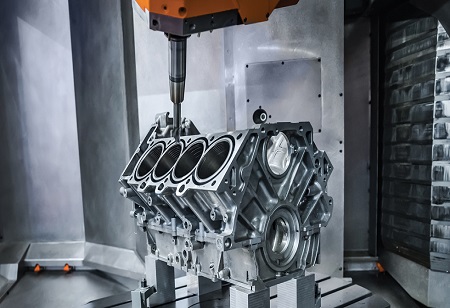
On-site or in-situ machining is one of the most amazing developments since the Machine Age that keeps the world's engine running. These on-site machining methods employ specialized, transportable tools and workshops to quickly make critical repairs or upgrades to buildings and machinery. In order to fulfill the enormous demands of the global market, modern enterprises survive on the constant, quick creation of goods and services.
There is a cascading effect when these goods and services are interrupted for any period of time. Customers are hit with higher prices or forced to look elsewhere to suit their demands when providers and manufacturers temporarily stop operations and logistics need to be rearranged.
The planning and execution stages of on-site machining continue to undergo significant change as a result of contemporary technical breakthroughs. While additive machining, which includes 3D printing, has the potential to usher in the next phase of manufacturing, production, and repair, robot machining and ultra precise machining with nano-technology have transformed the field of on-site machining as a whole.
3D Printing
By layering material, often one "sheet" or layer at a time, three-dimensional items may be made using the computer-controlled machining technique known as 3D printing. Though initially restricted to a small number of uses, 3D printing has achieved astounding levels of precision machining with a wide variety of materials.
This kind of additive manufacturing can create intricately complex forms, components, and work pieces using computer-aided design (CAD) files and digital 3D models. Traditional 3D printing is closely related to fused filament fabrication, which manufactures products using resins and polymers.
Metal powder bed fusion is becoming more popular, which points to the revolutionary potential of consistently printing metal parts with exact tolerances. In the near future, onsite machining techniques are projected to make substantial use of this technology.
Even while 3D printing and CNC machining are cutting-edge technologies in and of themselves, they are competing with even more recent technological advancements. The rate of technical progress advances as technology advances; rather than additive increases, as they were for the majority of history, present technology multiplies and momentum compounds. With the introduction of generative, era-defining sciences like nanotechnology and robotics, this rate of development is anticipated to surpass multiplicative growth and enter the realm of exponential rise.
For a variety of reasons, including the fact that they are fundamentally transformational technologies with almost endless potential applications, robotics and nanotechnology are passionately discussed subjects in the STEM and medical sectors.
Robot Machining
Robots have a presence in industry thanks to their adaptability, intricate machine paths, frequently enormous workplaces, and quick output. Robots have been employed in industrial manufacturing for more than ten years for a variety of operations, including assembling, handling, machine tending, machining, spray painting, and welding. Robotics will undoubtedly continue to be widely used in industrial applications, but there is a problem.
Robots can readily handle machining tasks involving relatively soft materials (foam, plastic, wood, some light metals). Precision is greatly decreased when using harder materials (aluminium alloys, bronze, copper, ceramics, steel, titanium, etc.). When compared to conventional machine tools, a robot's lack of rigidity or stiffness is a definite disadvantage since the tool slides when it comes into touch with tougher materials. When compared to conventional machine tools, the consequent errors of cutting on hard materials are a constraint for robots.
Harder materials pose challenges for robots, but they nevertheless have a variety of benefits when it comes to machining. While using 6 degrees of freedom (vs the 3–4 that CNC machines typically use), the robot may be moved from job to task while milling, drilling, and turning. If the materials have suitable hardness, complex designs are considerably easier to produce with a robot.
Robots will need to be further developed in order to function in many onsite machining applications as they are now limited to machining for softer materials in industrial applications. Robot machining offers the valuable and much desired versatility to handle complex designs, which is guaranteed to catch the attention of many brilliant engineers and developers for future application.
Ultra-Precise Machining with Nano technology
Engaging matter at the nanoscale, or between 1 and 100 nanometers, is what nanotechnology entails. A human hair has a width of around 80,000 to 100,000 nanometers; a nanometer is one billionth of a meter. Nearly one-third of a nanometer is the size of a single gold atom. Even though the size is hard to comprehend, scientists and engineers have made remarkable advancements in their capacity to interact with materials in this impossibly small area.
Since at least ten years ago, nanoscale machining has been made feasible and is currently used in a variety of fields, including automotive, biotechnology, electronics, medicine, ultra-precision optics, and watchmaking. Nanoscale milling, turning, grinding, and finishing can be done using CNC diamond turning lathes with up to 5 axes. These amazing devices can polish surfaces on a sub-nanometer scale and deal with a wide range of materials. Although onsite machining processes may be some distance from the forefront of nanoscale machining, it won't be long before these methods are used on a far wider range of materials.
Technology and scientific advancements in a variety of sectors have made it possible to create extraordinarily sophisticated, highly portable machine tools that can repair and revive worn-out equipment and components that are necessary for day-to-day operation in almost any modernized, scaled human effort. Providing this service removes any question that on-site machining will continue to be a fundamental component of industry for the foreseeable future, just as traditional machining techniques have existed since the beginning of written history.
The safety, efficacy, and efficiency of on-site machining services will only grow as science, technology, and engineering continue to progress. This is illustrated by technological advances like 3D printing and CNC machining. Future technologies are just beyond the horizon, full of potential and waiting for further development.
We use cookies to ensure you get the best experience on our website. Read more...